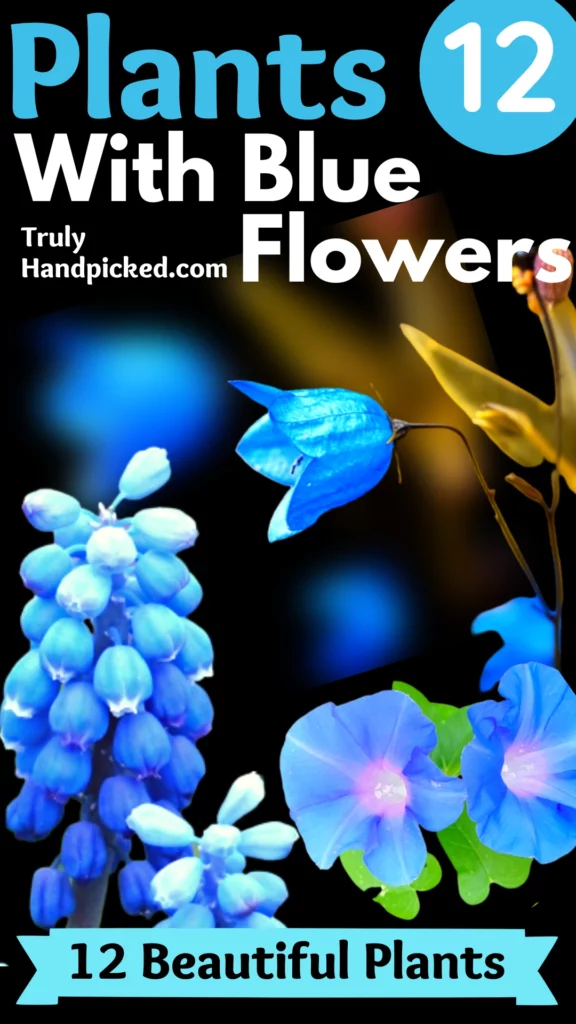Blue is an imperial shade indeed, and it can add a dash of royalty when included in your garden area. From indigo to teal and from turquoise to navy blue, any pattern of blue seems amazing, when comprised in a flowering garden.
If you are planning to have a vibrant decorative garden in your yard or small indoor space, don’t forget to add this shade to your garden, ever.
Blue flowers can unforgettably cherish your garden. So, here we come up with the 12 best flowering plant options for you, which are super easy to cultivate in any gardening condition-
10 Beautiful Plants with Bluish Flowers
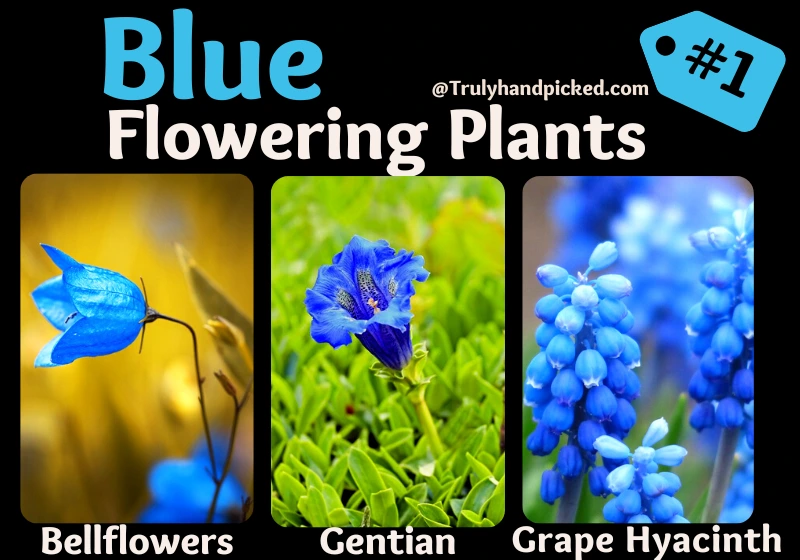
Blue Bellflowers:
Campanula aka bell flowers is one of the commonest options of blue flowers. The striking bell-shaped blossoms look amazing while growing in the cluster.
Soil and Water: Loose and sandy type soil with a well-drained quality
Consistently moist soil with a steady watering schedule, around once every week
Sunlight and Climate: The plant will thrive best when placed in the sun with partial shade. It prefers moderately warm temperatures about 60° to 70° F with an average humidity level.
Fertilizer: Any all-purpose balanced fertilizer once a year with a 5-10-10 NPK ratio
Blooming Time: 3-4 weeks before the late spring and early summer
Gentian (Blue):
It is one brilliant option to go with, for vibrant blue blossoms. It is a perennial flowering plant that grows narrow funnel-shaped flowers in royal blue shade.
Soil and Water: This plant also prefers loose and well-draining soil that must be moist and has a slightly acidic pH level. Water the plant regularly with a mild amount to keep it evenly moist throughout the whole growing session.
Sunlight and Climate: It prefers full sun exposure to the sun with partial shade. Keep the climate constantly warm with a temperature between 65° to75° F and high humidity level.
Fertilizer: This plant is a low-feeder, so, you can apply any slow-release water-soluble fertilizer once every 2-to 3 months.
Blooming Time: Early March to December
Grape Hyacinth:
This perennial bulbous plant produces tiny flower buds in stalks in a pale blueish shade.
Soil and Water: The plant prefers moist, rich well-drained soil with a neutral to acidic pH balance. Try watering once every 7-9 days and let the soil dry between watering
Sunlight and Climate: It can stand full sun exposure to the sun with partial shade
Fertilizer: Organic fertilizer is the best pick for this plant. Apply bone meal in dry form to feed this plant properly
Blooming Time: Spring
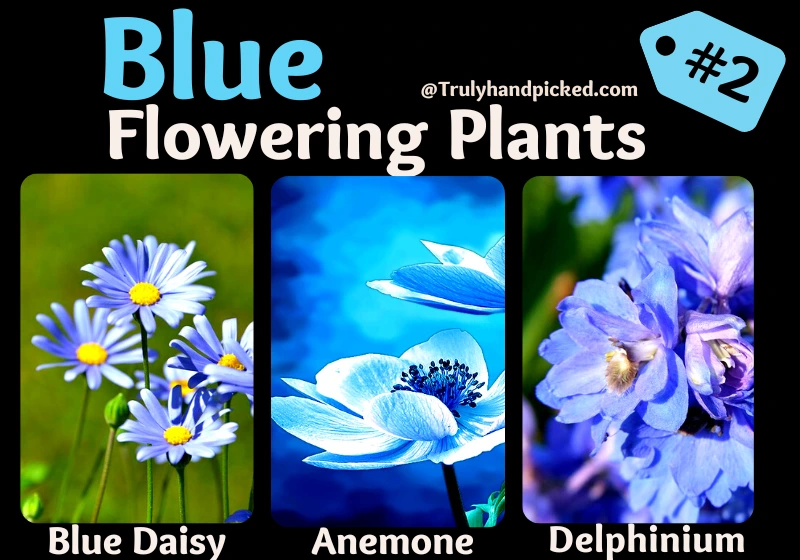
Felicia – Blue Daisy:
If you are looking for blue flowers in a wide shade, a blue daisy could be the right pick for you. Its royal blue-colored flowers seem more attractive while fully bloomed due to the yellowish pistol part, at the center of the deep blue petals.
Soil and Water: This plant needs loose soil with well-drained quality and a balanced pH level
Water the plant once a week and let the topsoil soak between watering
Sunlight and Climate: It can stand full sun exposure. Keep the climate always warm between 65° to 85° F temperature and with moderate humidity
Fertilizer: Try to use all-purpose fertilizer in diluted form with a 10-10-10 NPK ratio
Blooming Time: Early to mid-spring
Anemone:
This species of buttercup family grows widely open pretty flowers in different elegant shades including blue ones.
Soil and Water: It claims rich and moist type slightly acidic soil that can drain excellently. This plant prefers regular watering to thrive well
Sunlight and Climate: Anemone plants can stand full sun exposure to the sun with partial shade. Maintain a temperature between 58° to 65° F with a high humidity level
Fertilizer: It prefers organic fertilizer like bone meal or well-rotten compost for a proper nutrient boost
Blooming Time: Spring to early summer
Delphinium:
Larkspur aka delphinium is one more good option to grow in your garden for bright blue flowers. its off-white central part makes the blossoms more striking inside the royal blue petals.
Soil and Water: It claims soil that is loamy, humus-rich, and drains well with a slightly alkaline pH balance
It prefers deep watering every 7-10 days with distilled water for the better thriving experience
Sunlight and Climate: Give your plant the sun with partial shade to provide bright indirect light for 6-8 hours every day. Keep the climate consistently warm with a high humidity level
Fertilizer: Apply any slow-release fertilizer in liquid form with a 10-10-10 NPK ratio
Blooming Time: Summer
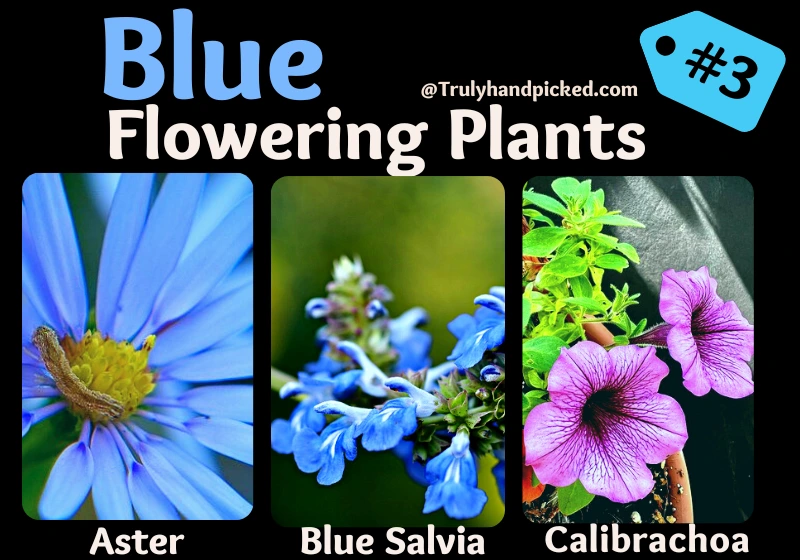
Aster – Purplish Blue:
Aster is one of the most beautiful flowering shrubs you can grow o your garden area effortlessly. It produces flowers with a dwarf-sunflower shape in a purplish-blue shade.
Soil and Water: It wants loamy, well-drained soil with a neutral to acidic pH level. Water your aster plant regularly to keep the soil constantly moist, especially during the summer
Sunlight and Climate: Place your plant under full sun exposure for the best result. Keep the growing temperature moderately warm and the humidity level mediumly high
Fertilizer: Apply any organic fertilizer like manure, compost, leaf mold, etc. to give your plant the proper nutrient boost
Blooming Time: Summer and fall
Blue Salvia:
Blue salvia is a perennial flowering plant that grows tiny flower stalks in royal blue shades. This plant always blooms in the cluster and thus, peeks amazingly, while cultivating outdoors.
Soil and Water: Use loose and organically rich soil with a neutral pH level. Water your plant thoroughly once every 6-8 days and apply to mulch
Sunlight and Climate: It can stand direct sunlight under full sun exposure. Keep the temperature moderately high and high humidity to provide the best growing condition
Fertilizer: Use compost during the plantation and don’t need to feed your salvia again in its entire growing session
Blooming Time: Spring, summer, and fall
Blue Calibrachoa:
It is another brilliant option to add a touch of classy blue flowers to your garden area. This plant produces small funnel-shaped flowers in a bright blue shade with a pretty yellowish pistil part.
Soil and Water: Plants need moist and rich soil with well-drain quality. Water your blue calibrachoa plant once every 9-10 days with deep watering. Let the soil dry a bit between watering
Sunlight and Climate: It can stand full sun exposure to the sun with partial shade, depending on the growing period. Keep the temperature medium to moderately warm with a high humidity level
Fertilizer: It is a heavy-feeding plant. Thus, you need to feed your plant once every 2-3 weeks with a slow-release balanced fertilizer in diluted form
Blooming Time: Spring to fall
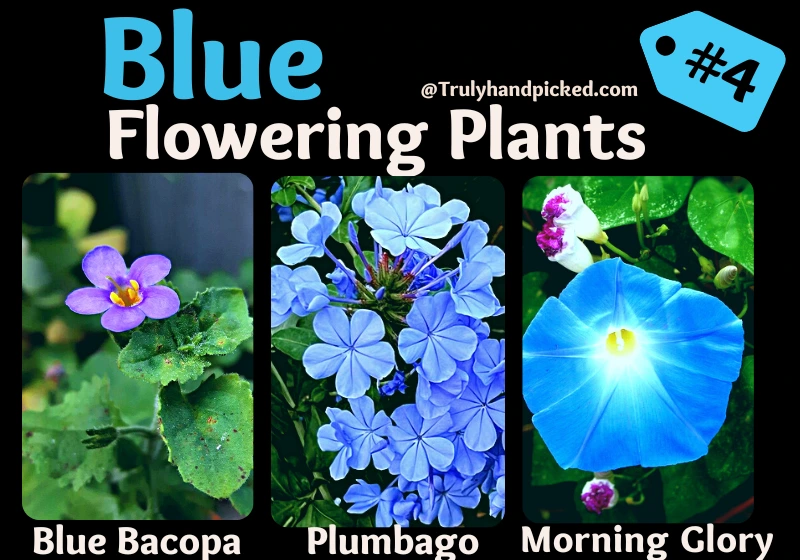
Blue Bacopa:
Blue bacopa is a bushy perennial shrub that grows small pretty-looking flowers in a purplish-blue shade with a highlighted pistil part.
Soil and Water: Use soil that is rich in organic matter and can drain excellently. Keep the soil pH level optimal. Water the plant once every few whiles, when you see that the top 1-inch of the soil turns dry
Sunlight and Climate: It can stand full sun to sun with partial shade to fulfill its bright-light requirement. This plant prefers warm temperatures between 65° to 75° F with a medium to the high humidity level
Fertilizer: Apply any slow-release water-soluble balanced fertilizer once every 2-3 weeks, especially, during the peak months
Blooming Time: June through October
Blue Plumbago:
This is one more blue flowering plant that produces a bloom in the cluster. Blue plumbago is one of the fast-growing perennial shrubs, which bloom all year long with moderate care, and attention.
Soil and Water: It can grow in normal clay-based garden soil but that can drain well. Water the plant regularly with normal water and reduce the watering to once every 3-4 days, during the winter season
Sunlight and Climate: It prefers the sun with partial shade for bright but indirect light. Keep your plant under moderately warm temperature and high humidity to provide it with the best growing condition
Fertilizer: Feed your plant every 2 weeks with an all-purpose fertilizer, and skip winter fertilization attentively
Blooming Time: May to October
Morning Glory:
Morning glory is one vibrant option to pick for vivacious blue flowers in wide shapes. It produces complete funnel-shaped flowers with curvy edges and petals with a luminous central part.
Soil and Water: It prefers soil rich in organic matter and loamy enough to drain well. Morning glory needs heavy watering, around 1-inch per week to thrive well.
Sunlight and Climate: This perennial herbaceous plant can stand under full sun to the sun with partial shade. Keep the temperature moderately warm like a tropical climate, around 65° to 5° F with any kind of humidity level.
Fertilizer: Feed your plant every 3-4 weeks with a low-nitrogen and high phosphorus fertilizer in a 5-20-10 NPK ratio.
Blooming Time: Early summer to late fall
